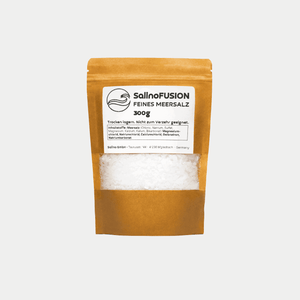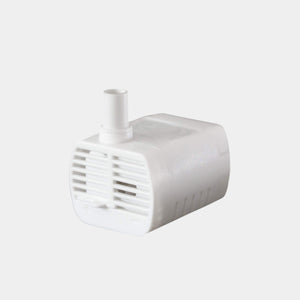Communication is the key in many areas of our lives. It's not just the subtleties between what is said and what is meant, but also the "mechanics of speaking". Respiratory diseases can have a significant impact not only on our physical health, but also on our ability to speak and express ourselves. You wake up one morning and find that your voice is hoarse or that you quickly become out of breath when speaking. What now? For many people with chronic respiratory problems, this is not a temporary inconvenience, but a daily reality.
In this article, we'll dive deep into the world of respiratory conditions and explore how they can affect our ability to speak. We'll highlight the important role speech therapy plays in addressing these challenges and explore how natural approaches like salt air therapy can provide additional support.
Respiratory Diseases: An Overview
Respiratory diseases are a group of illnesses that affect the lungs and other parts of the respiratory system. They range from acute infections to chronic conditions that can significantly affect the lives of those affected. The most common respiratory diseases include:
Asthma : A chronic condition in which the airways become inflamed and narrowed, causing shortness of breath, coughing, and wheezing.
Chronic obstructive pulmonary disease (COPD) : A group of lung diseases, including chronic bronchitis and emphysema, characterized by narrowing of the airways.
Bronchitis : An inflammation of the bronchi, which can be acute or chronic and often leads to coughing and increased mucus production.
Pneumonia : An infection that causes inflammation of the alveoli in the lungs, resulting in shortness of breath and coughing.
Cystic fibrosis : A genetic disease that causes overproduction of thick mucus in the lungs.
Allergic rhinitis : An allergic reaction that affects the lining of the nose, causing congestion, sneezing, and nasal discharge.
These diseases can not only make breathing difficult, but also have a significant impact on the ability to speak and the quality of the voice of those affected.
How respiratory diseases affect speech
The connection between breathing and speaking is close and complex. Our voice is created when air from the lungs passes through the vocal folds (cords) and causes them to vibrate. Any impairment of this process can lead to speech and voice disorders. Here are some specific ways that respiratory diseases can affect speech:
Voice changes:
Hoarseness: Many respiratory illnesses, especially those that involve coughing, can cause irritation of the vocal cords. This can cause a hoarse or rough voice.
Vocal fatigue: People with respiratory diseases often feel that their voice tires more quickly, especially when speaking for long periods of time.
Breathing support for the voice:
Shortness of breath when speaking: Patients with conditions such as COPD or severe asthma often have difficulty speaking long sentences without becoming out of breath.
Irregular speech rhythm: Impaired lung function can lead to an irregular speech rhythm because patients have to take more frequent breaks to breathe.
Articulation problems:
Nasal resonance: In conditions such as allergic rhinitis, a blocked nose can lead to altered nasal resonance, affecting the pronunciation of certain sounds.
Slurred speech: Breathing problems may cause patients to speak faster or more unclearly to avoid periods of shortness of breath.
swallowing problems :
Many respiratory diseases increase the risk of swallowing disorders (dysphagia), which in turn can affect speech production.
Vocal Cord Dysfunction (VCD) :
This disorder, in which the vocal cords close inappropriately during inspiration, is often confused with asthma and can cause significant speech and breathing problems.
Psychosocial effects :
The constant worry about shortness of breath or coughing fits can lead to fear of speaking, which further limits the ability to communicate.
An impressive study by Ritz et al. (2014) entitled "Voice Disorders in Adult Asthma" highlighted the prevalence of voice disorders in asthmatics. The researchers found that 58% of the adult asthmatics studied reported voice disorders, compared to only 7% in the healthy control group. This study illustrates how closely respiratory diseases and speech problems are intertwined.
The Role of Speech Therapy
Given the wide range of effects of respiratory disease on speech and voice function, speech therapy plays a crucial role in the comprehensive treatment of these patients. Speech therapists are experts in communication disorders and work closely with doctors and other health professionals to provide comprehensive care to patients.
Here are some of the key areas in which speech therapists can support patients with respiratory conditions:
Voice therapy :
Speech therapists can help patients use their voice more effectively and gently by using vocal hygiene exercises, voice amplification techniques, and strategies to reduce vocal fatigue.
In patients with chronic laryngitis or vocal cord edema, special exercises can help improve voice quality and reduce pain.
breathing techniques :
One of the most important tasks of speech therapists is to teach patients how to use their breathing effectively for speech. This may include techniques such as pursed lip breathing or diaphragmatic breathing .
For patients with COPD or severe asthma, speech therapists can teach strategies to help them make the most of their limited breathing capacity for speaking.
Articulation exercises:
For patients with nasal resonance due to allergic rhinitis, speech therapists can offer special exercises to improve articulation and resonance.
Techniques to improve clarity when speaking quickly or unclearly may also be part of therapy.
Management of Vocal Cord Dysfunction (VCD) :
Speech therapists play a key role in the diagnosis and treatment of VCD. They can teach patients how to relax and open their vocal folds during breathing.
Swallowing therapy :
For patients with swallowing disorders, speech therapists can teach exercises and techniques to make swallowing safer and more efficient.
Psychosocial support :
Speech therapists can help patients develop strategies to deal with fear of speaking and increase their confidence in communication situations.
respiratory muscle training :
Special exercises to strengthen the respiratory muscles can improve breathing capacity and thus indirectly support the ability to speak.
Use of aids :
In some cases, speech therapists may recommend the use of assistive devices such as voice amplifiers to facilitate communication.
Speech therapy treatment is usually tailored to the specific needs and challenges of each patient. A typical treatment session might go like this:
- Assessment of current speech and voice function
- Performing specific breathing exercises and voice exercises
- teaching strategies for everyday life
- Review of progress and adjustment of the treatment plan
It is important to emphasize that speech therapy must be carried out conscientiously and usually over the long term. Initial successes must be consolidated with ongoing training. Motivation should always be maintained. Cooperation and trust between the patient, speech therapist and other medical professionals is crucial for the success of the therapy.
The Role of Salt Air Therapy
While speech therapy works directly to improve speech and voice function, there are complementary therapies that can support overall respiratory health. One such therapy may be salt air therapy, also known as halotherapy.
Salt air therapy is based on the principle that inhaling fine salt particles can have a positive effect on the respiratory system. This form of therapy has its roots in the traditional use of salt caves for healing purposes and also the generally accepted belief that sea air helps with respiratory problems.
Here are some of the potential benefits of salt air therapy, especially in the context of respiratory diseases and speech problems:
- Anti-inflammatory effects : Studies suggest that salt aerosols have anti-inflammatory properties. This could be particularly beneficial for patients with inflammatory airway diseases such as asthma or chronic bronchitis.
- Expectorant effect : Salt particles can help to liquefy thick mucus in the respiratory tract, making it easier to remove. This can make breathing easier and indirectly improve the ability to speak.
- Antibacterial properties : Salt has natural antibacterial properties that may inhibit the growth of pathogens in the respiratory tract.
- Improvement of lung function : Some studies have shown that regular salt air therapy can lead to an improvement in lung function parameters. This could have a positive effect on respiratory support during speech.
- Hydration of the airways : Inhalation of saline aerosols can help moisten the airways, which may be particularly helpful for patients with dry mucous membranes or chronic cough.
- Stress reduction : The calm environment in salt rooms can contribute to stress reduction, which may indirectly have positive effects on respiratory and speech symptoms.
Scientific studies have investigated the effectiveness of salt air therapy for various respiratory diseases:
- A study by Rashleigh et al. (2014) showed significant improvements in lung function and quality of life in COPD patients after regular salt air therapy.
- Bar-Yoseph et al. (2017) found improvements in lung function and a reduction in inflammatory markers in children with asthma after salt air therapy.
- Elkins et al. (2006) observed improved lung function and reduced sputum production in patients with cystic fibrosis after saline air therapy.
Salt air therapy can be considered a complementary treatment, but should not be considered a replacement for conventional medical therapies. Patients should always consult their doctor before starting salt air therapy.
Synergy between speech therapy and salt air therapy
The combination of speech therapy and salt air therapy could be a promising approach for the comprehensive treatment of patients with respiratory diseases and associated speech problems. Here are some possible synergistic effects:
- Improved airway function : While salt air therapy can clear the airways and reduce inflammation, speech therapy exercises can improve breathing control and coordination. This could lead to overall more efficient breathing and therefore better voice production.
- Voice improvement : The anti-inflammatory effect of salt air therapy could alleviate voice problems, while speech therapy voice exercises optimize voice production. This could be particularly beneficial for patients with chronic laryngitis or vocal cord edema.
- Swallowing function : Salt air therapy can moisten the mucous membranes and thus facilitate swallowing, while speech therapy improves swallowing technique. This could reduce the risk of aspiration.
- Speech fluency : Improving lung function through saline air therapy and breathing coordination exercises in speech therapy could improve speech fluency. This would be particularly helpful for patients who have difficulty speaking long sentences due to shortness of breath.
- Holistic treatment of VCD : While speech therapists teach specific techniques to control vocal cord dysfunction, salt air therapy could support overall airway function and potentially reduce the frequency of VCD episodes.
- Stress reduction and psychosocial aspects : The stress-reducing effect of salt air therapy could support the work of speech therapists in dealing with speech anxiety and other psychosocial aspects of speech and voice disorders.
The specific synergistic effects between speech therapy and salt air therapy have not yet been comprehensively investigated scientifically. However, further research in this area is likely to provide valuable insights and possibly lead to optimized treatment protocols for patients with respiratory diseases and speech problems.
Practical Application: The Role of the Mini-Saline
While professional salt rooms and grottos enable intensive salt air therapy, it is not practical for many patients to visit such facilities regularly. In particular, relocating speech therapy rooms is probably only feasible in a few cases, although salt caves may be attractive as a practice. For the large number of speech therapy centers and rooms, however, portable salt inhalers or the SalinoVatis Mini-Saline can come into play. These compact devices enable patients to enjoy the potential benefits of salt air therapy in the comfort of their own home or on the go.
They offer several advantages:
Convenience :
Patients can perform the supported exercises anytime and anywhere, allowing for more regular use, not just with the speech therapist in the practice rooms.
Cost efficiency :
Compared to regular visits to salt rooms, mini saline units can be a more cost-effective long-term option.
Individual customization :
The duration and frequency of use can easily be adapted to the patient's individual needs and daily routine.
simultaneity :
The mini saline in particular can be left running in the background during therapy sessions and exercises at home, so that salty air is constantly available to improve voice training. Inhalers, on the other hand, are suitable for starting or pausing exercises, but cannot be used while speaking, for example.
Conclusion and Outlook
Respiratory diseases pose a significant challenge to the health and quality of life of many people. Their effects go far beyond pure breathing and sometimes significantly affect the ability to speak and communicate. Speech therapy plays a crucial role in this complex field by helping patients to communicate effectively despite their illness and improve their quality of life.
The integration of complementary therapies such as salt air therapy into the treatment of respiratory diseases and related speech problems shows promise. While scientific evidence for some applications is still limited, the existing studies suggest potential benefits that are worth further investigation.
The future of treating respiratory diseases and related speech problems is likely to lie in a holistic, multidisciplinary approach that could combine the expertise of pulmonologists, ENT specialists, speech therapists and other specialists, incorporating both traditional and innovative forms of therapy such as salt air therapy.
It is important for patients affected by respiratory disease and speech problems to speak openly with their doctors and therapists about their symptoms and challenges. Only through open communication and a comprehensive assessment can individualized treatment plans be created that address all aspects of the condition.
Finally, further research is needed to better understand the complex relationships between respiratory disease and speech problems and to evaluate the effectiveness of different treatment approaches, including the combination of speech therapy and salt air therapy. As research and technology advance, we can hope that even more effective and personalized treatment options will be available for people with respiratory disease and speech problems in the future.



